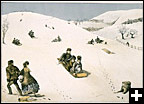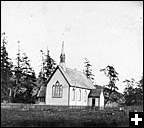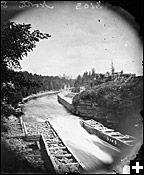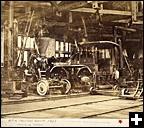Common menu bar links
Canadian statistics in 1867
Archived Content
Information identified as archived is provided for reference, research or recordkeeping purposes. It is not subject to the Government of Canada Web Standards and has not been altered or updated since it was archived. Please contact us to request a format other than those available.

On July 1, 1867, the four founding provinces officially became the Dominion of Canada. As this was the most significant year for Canadian unity, it was an appropriate year for the first unified Year-Book and Almanac of British North America for 1867; Being an Annual Register of Political, Vital and Trade Statistics, Tariffs, Excise and Stamp Duties; and All Public Events of Interest in Upper and Lower Canada; New Brunswick; Nova Scotia; Newfoundland; Prince Edward Island; and the West India Islands. The 1867 edition was a comprehensive summary of Canadian statistics and a precursor to today’s Canada Year Book.
Published prior to Confederation, the contents of the book were separated by area or territory: the United Province of Canada, including both Ontario and Quebec; the Colonies of Nova Scotia, New Brunswick, and Prince Edward Island; and the Colony of Newfoundland.
The 1867 edition attempted to cover topics such as the census, acts passed in Parliament and patents on recent inventions. It provided many names, lists, numbers and tables.
In 1861, the population of ‘Canada’ was 3,295,706 people. Based on the 1861 Census and the Newfoundland Census of 1858, the fastest-growing province was Upper Canada, or Ontario, at a rate of 4.34% a year, followed by the Colony of New Brunswick, at 2.60%.
Certain numbers were advised to “be taken to be tolerably accurate.” Figures included projections by the 1867 edition staff for 1900, over 30 years into the future, when they envisioned a new Dominion brimming with almost 12 million people.
Who were the Canadians of 1867?

In 1867, 79% of the people living in Canada were born in Canada. These 2,616,063 people were called “Natives of British America.” As for the rest of the population, nearly 1 million Canadians were of French origin, while the remainder were of English, Welsh, Irish, Scottish and “Foreign” origins.
Most immigrants to Canada settled or passed through the United Province of Canada. Of the 18,958 people that arrived in 1865, “about 16,000 appear to have settled in Upper Canada, and the remainder in Lower Canada.”

The 1867 edition also commented on “Statements of the Religious belief of the people of the Provinces.” In 1861, 1,465,979 people were Roman Catholic, 517,542 people were of the Church of England, 498,646 were Presbyterians, 458,388 were Wesleyans and Methodists, 192,530 were Baptists, 29,651 were Lutherans, 18,104 were Congregationalists, 78,735 people followed “Miscellaneous Creeds” and almost 19,000 people were “Of no religion.”
To help readers interpret these data, the following note was included in the 1867 edition underneath the table on creed: “Thus, although the new Confederation cannot be called a Roman Catholic country, the Protestants number 55 per cent of the whole population, still the Roman Catholics are undoubtedly of far more numerical importance than the members of any other single denomination.”
Where did they work?
At this time in Canada’s history, the place a person lived largely dictated what kind of job they could have because of what was available. According to the 1867 edition, “the people of the Western Part of the New Confederation are almost exclusively occupied in Agricultural pursuits; in the Far East, the Fisheries monopolize their labor; in the Central portion, Lumbering is an important industry; while Manufacturing begins to be of consequence in many of the cities, and Mining in a few outlying districts.”
Out of 837,718 recorded labourers, approximately 41% (342,649) of jobs were on the farm. In the year 1860 alone, a total of 28,213,760 bushels of wheat, 39,506,359 bushels of potatoes, and 45,634,806 bushels of oats were produced. In 1866, the top agricultural export was flour, with a value of $5.2 million. The second most valuable export was raw barley and rye, with a value of $4.6 million, and the third was raw wheat, with a value of $3.1 million.
Almost 90,000 people were involved with the fisheries, two-thirds of whom lived and worked in Newfoundland.
The shipbuilding industry was a growing industry in Canada, with Nova Scotia, New Brunswick and Prince Edward Island producing a total of 572 new vessels in 1865, up from 399 new vessels in 1860. In an explanatory note, the 1867 edition says that “Owing principally to the abundance and excellence of timber, but partially to other causes, ships can be built here much more cheaply than in Europe, and 40 per cent cheaper than even in the United States.”
Labourers and lumbermen counted for 211,243 of all recorded labourers in the early provinces. In 1864/1865, the quantity of lumber exported was worth close to $13 million.

What was developing in Canada?
The 1867 edition looked closely at various aspects of Canada’s development, such as international trade and infrastructure.
Great Britain and the United States bought the majority of exports from Canada’s mines—mainly copper ore and iron. In the year ending in June 1866, the value of metal exports was almost $350,000. Foodstuffs and other items were exported to many countries. Canada was also investigating trading options with countries in the tropics, including British Guiana, Jamaica, Barbados, Trinidad, Antigua, St. Domingo, Cuba, Puerto Rico and Brazil.
These early years showed promise for Canada’s infrastructure. Electric Telegraph stations were prevalent in every province of British North America, to a total of 471 stations. By 1865, the Grand Trunk Railway, which included the Montréal and Champlain and the Buffalo and Lake Huron railways, was 1,377 miles long and its road and equipment alone had cost $81 million.
How did they pay for goods and services?

Several currencies were considered legal tender, although Canadian dollars were used in public accounts. The pound currency, pound sterling, “gold Eagle of the United States,” and British silver coins were considered legal tender. The Canadian dollar was defined to be “one fourth of a pound.” Paper money of Canada was issued in denominations of $1 and $4, in addition to other denominations still issued today.
